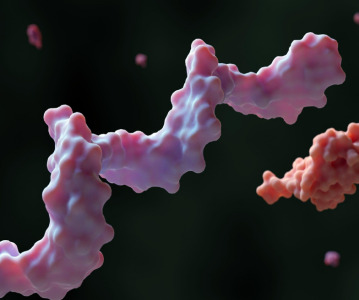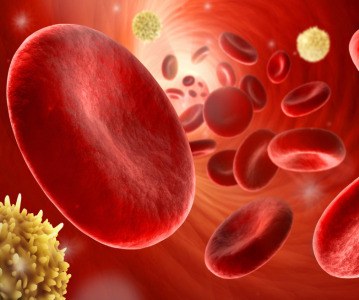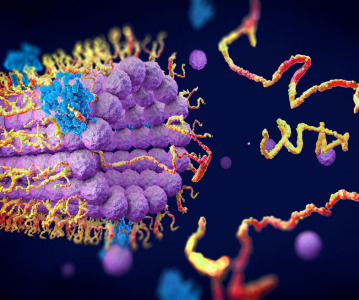New targeted drug effectively dissolves blood clots

The new drug is safe for intravenous injection and can dissolve clots up to 4000 times more efficiently than ordinary enzyme-based drugs.
Scientists from ITMO University in co-operation with Mariinsky Hospital in Saint Petersburg have developed a magnetically controlled drug that can be condensed on a blood clot by means of a magnetic field. The new drug is safe for intravenous injection and can dissolve clots up to 4000 times more efficiently than ordinary enzyme-based drugs. The new study will also help reduce drug dosage, thus avoiding numerous side effects. The results of the research were published in Scientific Reports.
The challenge is that thrombolytic drugs do not target the clot, but rather spread over the whole circulatory system. The organism begins to block a foreign enzyme, quickly diminishing its activity. Therefore, the drugs are injected in knock-out doses in hope that at least a small portion will reach the blood clot on time. "Now we are using a sledge-hammer to crack a nut", says Ivan Dudanov, head of the regional cardiovascular center of Mariinsky hospital. "Dissolving a little blood clot that blocked a vessel of only 1-2 mm in diameter, thrombolytic drugs negatively affect the entire network of blood vessels. To change the situation, we decided to develop a method of targeted drug delivery that would allow us to considerably reduce the dosage and ensure that the whole therapeutic effect is focused on the clot."
The scientists produced a composite material, which can deliver thrombolytic enzymes in a safe and targeted manner. The new material is composed of a porous magnetite framework and molecules of urokinase — an enzyme frequently used in medicine as a thrombolytic agent. The composite can be used to create thrombolytic coating for artificial blood vessels and stable injectable solutions made of nanosized particles that can be easily localized near the clot by means of an external magnetic field.
Importantly, the magnetite framework also protects enzymes from various inhibitors that are present in the blood and can deactivate thrombolytic medications. Andrey Drozdov, first author of the study and researcher at the Laboratory of Solution Chemistry of Advanced Materials and Technologies notes: "Usually, in order to achieve a prolonged effect for such drugs, the enzyme is placed inside a polymeric matrix. The enzyme is then gradually released from the matrix and eventually looses all activity. We, on the other hand, experimentally demonstrated that enzymes protected using our approach do not lose therapeutic properties over extended periods of time and even after repeated use. The rate, at which the new drug can dissolve the clot outperforms unprotected enzymes by about 4000 times."
The material is potentially safe for humans, because it is made of components that already have permission for intravenous injection. According to Professor Dudanov, future drugs based on the new composite could be used not only for thrombosis treatment, but also for its prevention. Circulating in the blood even in small amounts, the enzyme can gently clean the vessels and will stay active for a very long time until it is naturally excreted through liver like an ordinary metabolite.
This work became a logical continuation of earlier studies devoted to the enzyme entrapment into sol-gel magnetite matrix and the production of magnetically controlled bioactive systems.
"In this phase of our project, we have demonstrated how the concept we developed works for more specific objects. We prepared a thrombolytic colloid and tested its effects on an artificial blood clots obtained from plasma and blood of humans, and thrombus extracted from patients. The results may soon allow us to try out the new thrombolytic system on mammals. Now we are preparing for preclinical studies," concludes Vladimir Vinogradov, head of the Laboratory of Solution Chemistry of Advanced Materials and Technologies.
Related News
-
News Google-backed start-up raises US$600 million to support AI drug discovery and design
London-based Isomorphic Labs, an AI-driven drug design and development start-up backed by Google’s AI research lab DeepMind, has raised US$600 million in its first external funding round by Thrive Capital. The funding will provide further power t... -
News AstraZeneca to invest US$2.5 billion in Beijing R&D centre
Amid investigations of former AstraZeneca China head Leon Wang in 2024, AstraZeneca have outlined plans to establish its sixth global strategic R&D centre in China. Their aim is to further advance life sciences in China with major research and manufact... -
News Experimental drug for managing aortic valve stenosis shows promise
The new small molecule drug ataciguat is garnering attention for its potential to manage aortic valve stenosis, which may prevent the need for surgery and significantly improve patient experience. -
News How GLP-1 agonists are reshaping drug delivery innovations
GLP-1 agonist drug products like Ozempic, Wegovy, and Mounjaro have taken the healthcare industry by storm in recent years. Originally conceived as treatment for Type 2 diabetes, the weight-loss effects of these products have taken on unprecedented int... -
News A Day in the Life of a Start-Up Founder and CEO
At CPHI we work to support Start-Up companies in the pharmaceutical industry and recognise the expertise and innovative angles they bring to the field. Through our Start-Up Programme we have gotten to know some of these leaders, and in this Day in the ... -
News Biopharmaceutical manufacturing boost part of new UK government budget
In their national budget announced by the UK Labour Party, biopharmaceutical production and manufacturing are set to receive a significant boost in capital grants through the Life Sciences Innovative Manufacturing Fund (LSIMF). -
News CPHI Podcast Series: The power of proteins in antibody drug development
In the latest episode of the CPHI Podcast Series, Lucy Chard is joined by Thomas Cornell from Abzena to discuss protein engineering for drug design and development. -
News Amgen sues Samsung biologics unit over biosimilar for bone disease
Samsung Bioepis, the biologics unit of Samsung, has been issued a lawsuit brought forth by Amgen over proposed biosimilars of Amgen’s bone drugs Prolia and Xgeva.
Recently Visited
Position your company at the heart of the global Pharma industry with a CPHI Online membership
-
Your products and solutions visible to thousands of visitors within the largest Pharma marketplace
-
Generate high-quality, engaged leads for your business, all year round
-
Promote your business as the industry’s thought-leader by hosting your reports, brochures and videos within your profile
-
Your company’s profile boosted at all participating CPHI events
-
An easy-to-use platform with a detailed dashboard showing your leads and performance







.png)